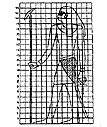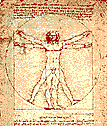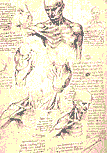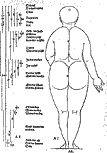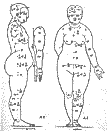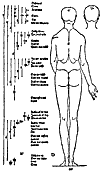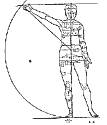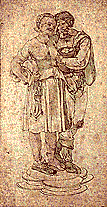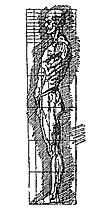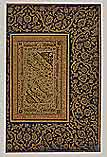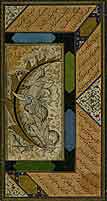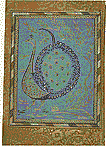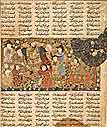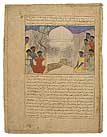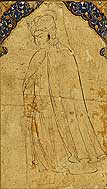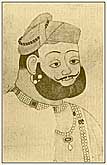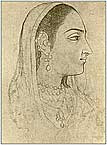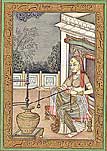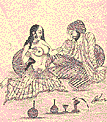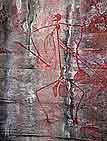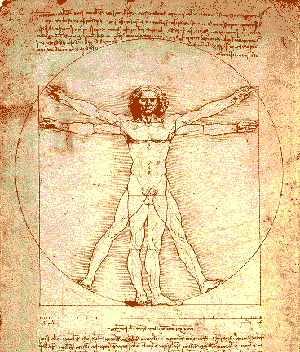[fig i] Leonardo da Vinci, 1492, Vitruvian Man, pen, ink, watercolour and metalpoint on paper, 343 x 245 mm, Gallerie dell'Accademia, Venice, (Source: http://www.wga.hu)
The significance of worldview
An astute student will have picked up the double meaning in the way that the term “point-of-view” has been used in these lectures. “Point-of-view” can be taken to mean one’s worldview, or in other words the system of values with which and through which one interprets and makes meaning of the world. At the same time, especially in the context of learning to draw, “point-of view” refers to the point from which one frames a view of a scene. In its most rigid interpretation, and usually in relation to drawing accurately from life, this may mean looking with one eye closed to make the frame of reference less ambiguous, and staying very, very still so that the aspect does not alter while you sketch, maybe using a grid-reference system and, maybe even calculating viewing distances and scales! More liberally, and especially in relation to applied illustration and visualisation, it means thinking about what angle(s) of view, what spatial and formal relationships, what conceptual relationships, what drawing styles, and so on, should be considered in order to effectively achieve the communication objectives?
It should be clear by now that these senses of “point-of-view” are in essence related. One’s worldview will have a profound influence on how one ‘frames up’ the world in the sense of one’s perceptual and cognitive understanding and, on how one represents it.
In the Post Modern era artists may be considered more fortunate in a number of ways compared to their forebears. Firstly, the existence of photography means that the pressure is off them to represent the world empirically. Photographers can do this better. It can be argued that a photograph is an automatic construction about a subject involving less intervention by the operator than is the case with an artwork. The latter is the product of many intentional acts. An artwork may or may not establish that the depicted object exists or provide much evidence about it (Scruton, 1983). Secondly, the Post Modern artist can be so much more aware through books, magazines, television, the Internet and other forms of remediation of the sheer diversity of art from historical epochs and of cultural artistic styles and mores, though arguably not in very knowledgeable depth. Certainly the Internet makes it much easier to search for image reference sources, information and inspiration. The down side of this availability of resource is, of course, information overload and too much choice to make sense of!
In this lecture it is intended to present a selection of historically identifiable and culturally specific modes of representation in order to show, on the one hand, how these may reflect prevailing world view from historically and culturally specific contexts, and to indicate, on the other hand, how these modes of representation never really go completely ‘out-of-date’ because we may still respond to them as visual systems. This is despite the fact that we may not be cognisant of the symbolic knowledge that would enable the apprehension of specific contextual meanings. However, with a little analytical interpretation we can come to appreciate how art reflects worldview and indeed how representational systems contribute to and perpetuate worldview.
The reading for this week is another essay by the art historian and cultural theorist Erwin Panofsky entitled, The History of the Theory of Human Proportions as a Reflection of the History of Styles. It is a fairly intensive scholarly work by today’s standards. It is included for the benefit of those who may appreciate more in-depth analysis of some of the historical material presented in this lecture. As such, it is suggested further reading and not required reading. Some of the ideas in Panofsky’s essay are summarized in this lecture. The main objective of the lecture is to show that different representation systems may have application for different purposes in contemporary communication.
Egyptian canon
“Its life, Jim, but not as we know it.” Star Trek fans will recognize this phrase and others will appreciate its meaning. It applies culturally as well as biologically and refers to situations where things may be so strange that we may not recognize them for what they are.
Perhaps this is the case with ancient Egyptian art where, as Panofsky says, “the optical refinements which correct the visual impression of the beholder are rejected as a matter of principle.” The mix of profile and frontal views that characterize the portrayal of figures makes them seem strangely alien to us. Panofsky holds that the Egyptian method was not maintained through ignorance but was the result of a “geometrical plan” that, he says Egyptians employed to reflect their worldview. The figures that appear so fixed to us were meant to portray a constant, timeless eternity. This was in keeping with beliefs about life and the afterlife. [fig: ii]
Panofsky says that the Egyptians employed a theory of proportions that stipulated objective dimensions at the same time as it incorporated technical dimensions. The artist fused frontal elevation, side elevation and plan into a single view. According to Panofsky,
...the Egyptian artist-theoretician first constructed a network of equal squares and then inserted into this network the outlines of his figure—unconcerned as to whether each line of the artwork coincided with one of the organically significant junctures of the body.
[fig iii] (Panofsky 1974, pp: 57-66)
This is art, but not as we know it!
Referring to a sketch of an Egyptian representation of a garden [reproduced here at fig: iv], Panofsky notes (in a different essay) that there is a combination plan—the water garden—and, elevation—surrounding trees, people etc. He does not think that the angled tress on the corners are examples of oblique projection but rather rotations to complete the pattern.
Byzantine schema
In the same essay Panofsky cites examples of European medieval art in order to demonstrate that a preoccupation with technique led artists to work according to the “principle of planimetric schematisation". He says that it is likely that this tradition originated in the arithmetic which the West inherited from Arabia and that it can be demonstrated to be of influence to artists right through to the seventeenth and eighteenth centuries. According to Panofsky the Arabian number system which, in turn may have been influenced by ideas from the Orient, had not been used in visual art but rather had been concerned with the “vast harmony that unifies all parts of the cosmos by numerical and musical correspondences”. But this cosmological origin had lost its significance by the time it was being applied in Byzantine art. The face, which is “the seat of spiritual expression” in Christian ideology, is taken as the base unit of measurement according to which the proportions of the whole body are measured, “the total length of the body ordinarily amounting to nine such units.” The base unit is subdivided into thirds when applied to the face itself and the employment of a “Three-Circle Scheme” of concentric circles, centered between the eyes, became widespread in frontal and three-quarter views. This technical idealization of the human form was based in some degree on the organic structure of the body but belies naturalistic appearance. According to Panofsky,
The canon of proportions here appears, not only as a symptom of the ‘Kunstwollen’ [worldview], but almost as the carrier of a special stylistic force.
[see fig v] (Panofsky 1974, pp: 72-83)
Gothic geometry
Panofsky refers to other examples of schematisation from the Middle Ages including the methods to expedite design proposed by French architect Villard de Honnecourt [see fig vi] Panofsky notes that the magical significance of the pentagram, which features here, plays no role in this method of drawing. The geometric schema is a purely technical device. ( Panofsky 1974 , pp: 84-87)
The geometric schema of Villard de Honnecort and the way that the nine-unit components of the Byzantine style were used as compositional aids are in many ways precursors to the schematic drawing techniques employed by some animators and the libraries of standard character aspects, views and movements that contemporary animation studios keep to speed up production.
The art connoisseur in Panofsky cannot restrain his scathing tone in his summation of the art of the medieval period. He seems to find it soulless in comparison with the art of the Classical Grecian period, which by contrast he reveres for its free interpretation of naturalistic form.
… in so far as the medieval theory of proportions followed the line of harmonious cosmology, it had no relation to art; and in so far as it stood in relation to art, it had degenerated into a code of practical rules which had lost all connection with harmonious cosmology.
(ibid, pp: 88-89)
Renaissance realism
Panofsky finds the “anthropometric” theories of proportion that arose out of the Renaissance much more in keeping with his Modern sensibility. According to him, during this time,
[t]he theory of human proportions was seen as both a prerequisite of artistic production and an expression of the pre-established harmony between microcosm and macrocosm; and it was seen, moreover, as the rational basis of beauty.
(ibid, p 89)
Leonardo da Vinci epitomises this approach, for although he did not document a written theory as such, as Panofsky claims that architect and co-inventor of perspective—along with fellow architect Bruneschelli—Alberti did, he prodigiously and prolifically explored visually structural anatomy and the dynamics of human movement and, according to Panofsky, “… managed to reduce all movements to a general principle which may be described as the principle of continuous and uniform circular motion.” (ibid, p 98) [see figs vii, viii]
However it is the German renaissance artist, Albrecht Durer who is credited by Panofsky and other art historians with the pursuit of a mathematical and yet adaptive method of quantifying the variable human proportions. “Firmly renouncing the ambition to discover one canon of beauty, he undertook the infinitely more laborious task of setting up various ‘characteristic' types which—each in its own way—‘should avoid crude ugliness'.” [see fig ix] ( ibid, pp: 101-103)
Durer's approach was obviously dissimilar to that of the medieval artists, being quite investigative and analytical. However, in this respect, there can be seen in his methodology aspects of approach akin to those applied today in by some contemporary cartoonists and animation artists.
Durer's dissatisfaction with the endeavour to find the human ideal led him to classify people in terms of types of physique [see figs x, xi, xii]. Many of the examples from the comprehensive catalogue of Durer's extensive works that is today readily available, suggest that Durer himself was a compassionate humanist [see fig ixx].
Point of view and subjectivity
Further, on the matter of worldview, Panofsky believes that the representative realism achieved during the Renaissance reflected a new kind of subjectivity and recognition by artists of both the uniqueness of their subjects and the interpretive involvement of the spectator. The paragraph where he expresses this is worth citing in full:
These two developments [Leonardo's ability to depict flexing and bending muscles, and his development of the principal of continuous and uniform circular motion] throw light on what is perhaps the most fundamental difference between the Renaissance and all previous periods of art. We have repeatedly seen that there are three circumstances which could compel the artist to make a distinction between the ‘technical' proportions and the ‘objective': the influence of the organic movement, the influence of perspective foreshortening, and the regard for the visual impression of the beholder. These three factors of variations have one thing in common: they all presuppose the artistic recognition of subjectivity. Organic movement introduces into the calculus of artistic composition the subjective will and the subjective emotions of the thing represented; foreshortening, the subjective visual experience of the artist; and those ‘eurhythmic' adjustments which alter that which is right in favour of that which seems right, the subjective visual experience of a potential beholder. And it is the Renaissance which, for the first time, not only affirms but formally legitimises and rationalises these three forms of subjectivity.
[fig xx] (Panofsky 1974, p 98)
The ideas in Panofsky’s essay have become a standard refrain for the art historians of the Western mass media and so have contributed to the popular notion that the Renaissance was a high point in civilization and the foundation of modern culture, perhaps only to be superseded by the scientific rationalism of late modernism.
Post Modern interpreters, analysts and historians of art, having borne witness to reactions against realism in the guises of Impressionism, Cubism, Surrealism, Abstract Art, Conceptual Art and a multitude of post-avant-garde ideologies and so on throughout the Twentieth Century, are now accustomed to diversity of point-of-view. Western colonial ventures of the Eighteenth and Nineteenth Centuries have been exposed in retrospect as having had the inevitable consequences of dispersal, assimilation and appropriation for the cultures that stood before them. And more recently, with increased awareness of the threat of ‘Disneyfication’ to their unique cultural heritage, nations the world over have a better understanding of how fragile their cultural integrity is, even if they have yet to discover an antidote to that global malaise.
While we can say that we now have knowledge of the proper ratios and proportions [see wikipedia link on human proportions] with which to represent the human anatomy with a realism that can be supported by photographic evidence, empirical measurement and all manner of biometric scanning techniques, there is ever more reason to have knowledge of the alternative representational systems from other cultures and historical epochs. Communicators who use illustration and visualization especially need to be aware of alternative ways of conceptualizing and representing actuality. Unfortunately it is beyond the scope of this lecture, and indeed this unit, to provide an in-depth and analytical survey of such alternatives. However in an attempt to counterpoint the rather traditional view of the progression of style in Western civilisation that is presented in Panofsky’s essay (however respectable and informative that may be) following is a sample of some different modes of representation arising out of other cultural and historical contexts.
Islamic non-representation
The influence of the Islamic faith on culture and art is so globally widespread and so varied through in intercultural interactions over sustained historical periods that any attempt to summarise it must belie the richness of that variety. It would be true to say though that the influence of the orthodoxy of the faith has tended to prejudice the decorative arts over the representative arts due to a fundamental belief in the sanctity of Allah's creative power and that attempts to represent the work of Allah are idolatry. Indeed, in 2001, the Taliban in Afghanistan instituted strict Islamic "Shariah" (law). They closed cinemas and prohibited photography (in any form) of live people [see note 1 below]. Liberal Muslims of the contemporary world have come to reconcile this fundamental tenet when they have embraced television, but for centuries religious calligraphy, geometric patterns and limited use of motifs based on plant and animal forms were the only images that were sufficiently abstracted to avoid transgressing this sacred notion.
Once again it should be stressed that because of the diversity of Islam itself there are many exceptions to be found. Particularly of interest are those artistic artifacts both historical and contemporary that arise from the interaction of Islamic and other cultures.
Fig [xxv] is 600 year old example of Byzantine illuminative art from North Africa that clearly shows a mixture of influence of Islamic and Christian ideology in its illustrative conventions.
Fig [xxvi] is by a contemporary North African artist. “Belkahia, whose work is based on the idea that memory shapes modernity, developed a new visual vocabulary grounded in indigenous culture… The signs and symbols are inspired by Berber tattoos and the Tifinagh-Tuareg and Berber alphabets. Arabic numbers, letters, circles, arrows, and triangular forms are reoccurring symbols in his work.”
Indian symbolism
The diversity of religion and culture that historically has contributed to civilization and which co-exists in India today is quite impossible to encompass in an overview. The following is nothing but an arbitrary selection and comment.
Jagdish Mittal, writing in a catalogue essay for an exhibition of Indian drawings from the collection of the Jagdish and Kamla Mittal at the Museum of Indian Art, Hyderabad says that rather than being examples of naïve art some of the drawings that show the combinations of view demonstrate the philosophy that “reality was more than what could be observed from a single focal point or a single perspective - that a reality existed that may be unseen from a certain vantage point - yet required to be conveyed.” Mittal adds,
Indian miniatures have also been criticized for their flatness - i.e. lack of body and shading, but here again, we might observe that a different value system may be at work. For instance, reality is never constant. Trees bend with the wind, birds fly around, people shake their heads and shift their body parts - none of this can be conveyed through any standardized rules concerning perspective. Sometimes a painting that appears to lack three-dimensionality may actually better convey a sense of motion than one that seems three-dimensional in appearance. Miniatures depicting dance scenes might float the dancers around curved lines set against a flat background to emphasize the fluidity of motion and to bring out the gaiety of the scene. Flatness also assisted the painter in shifting focus away from individuals to broader groups such as an ensemble of dancers or ensemble of musicians, or a crowd at a festival.
Mittal says that the artist rarely drew directly from nature. He points out that such artists are trained to work in a highly conceptual manner. The human figures, animals, birds, trees, motifs or any other elements of a composition are readily drawn from memory. The artist observes and retains these in memory. The salient features, characteristics and moods of both animate and inanimate subjects are drawn from such internalised accumulations. (Mittal n.d.)
There are many traditions, genres and sub-genres in Indian art. Folk art is pervasive.
There is a strong tradition of portraying psychological insight in some Indian ‘genre’ art . The adjacent images, the first of the goddess Radha [fig xxxi] and the second of a distracted man with a courtesan [fig xxxii] are two fine examples.
Figures [xxxiii] and [xxxiv] are contemporary renditions of Hindu mythology. As such, the figures depicted together with the action they are engaged in are richly symbolic. In other words, the meaning conveyed in the images extends more broadly through Hindu culture than what is actually shown in the images.
Australian Indigenous worldviews
Australia is a big country. Prior to the arrival of Europeans there were many Indigenous language groups, each with there own customs, beliefs and unique style of representing worldview in the pictures they made. The ancient images that we see today on rock faces are were often ceremonially repainted on a regular basis, and today some of them still are.
In contemporary Indigenous Australian art it is common for images to depict the landscape as seen from above and for relationships between people, natural resources and animals and ancestral beings to be symbolically represented roughly similar to the sense in which a map is used. The relationships may be depicted as symbolic signs, imprints, traces and transformations. In some cases, in the preparation of the artwork, there may be a ceremonial re-enactment or at least a re-narration of these relationships. In this sense the painting does not represent at all. Rather, it may relive relationships or defer to the ancestors. The artist may also have a sense of custodianship and responsibility to re-enact stories correctly, to the appropriate audience and in the right context.
To see some examples of contemporary picture stories from Yuendumu in the Northern Territory refer to Bear-Wingfield, R., 1996, Sharing good tucker stories : a guide for Aboriginal and Torres Strait Islander communities, Commonwealth Department of Human Services & Health. Pages 127-129. The picture stories are annoted with explanations of their meanings. These pages of the book are reproduced in the CQU library CRO collection.
Style, iconography and iconology
Pictures such as the examples of Hindu symbolism referenced above, most art from the Medieval and Renaissance period and, much Indigenous art—indeed, wherever the conceptual content of the imagery is strongly inter-related with stories and ways of seeing that more broadly permeate a culture and, where drawing styles and genres may be influenced by social as well as personal characteristics—may, according to Panofsky, be analysed in three significant and related but different aspects:
• style (referring to the way objects and events are represented in terms of forms and artistic motifs);
• iconography (where types of specific themes and concepts as referenced by other images, stories and allegories in the verbal culture and literature, may be expressed by objects and events); and,
• iconology (where symbols with intrinsic meaning or content are used to stand in for and refer to essential tendencies of the human mind).
(Panofsky 1974, pp: 40 -41)
However to undertake in-depth and meaningful iconographic and iconological analysis requires:
• knowledge of the mythological sources (in respect to iconography); and,
• psychological and social insight about the state of mind of the artist and their situating worldview (in respect to iconology).
Note also that some art historians do not differentiate between “iconography” and “iconology” the way that Panofsky does. In such cases the term “iconography” may be taken to encompass all of the terms of reference that Panofsky separates out into two classes.
In this lecture, which has been a preliminary overview, there has been no attempt to analyse in depth the iconography or iconology of the images presented. This, after all is not an Art History course as such. To perform such analysis this author may have called on and cited expert sources. It is possible to make useful comparisons between works of art where the same symbolic content may be identified and can be said to have been used differently in terms of style. For example, below are two paintings of the same mythological subject matter by two Italian painters, roughly contemporaneous in the Renaissance period: Annibale Carracci [pic xxxvii] and Paulo Veronese [pic xxxiii].
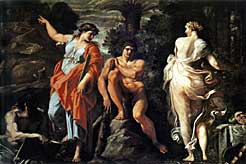 [xxxvii]
[xxxvii] 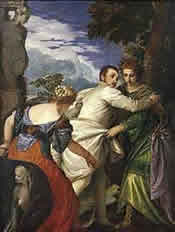 [xxxviii]
[xxxviii]
Both depict a classical myth where Heracles (or Hercules in the Roman version of the Greek original) has to make a choice between “Virtue” and “Vice”. Carracci chose to have his female models clothed in ancient costume and his Heracles unclothed whereas Veronese depicted all of his characters in the fashionable garb of his own time and place. A stylistic analysis may note this fact, and would be mostly concerned with compositional and technical aspects to do with how each work was painted, whereas iconographical discussion would not only make this observation but also involve going into the reasons why each artist may have made such a choice.
References
Panofsky, E, 1974, “The history of the theory of human proportions as a reflection of the history of styles”, in Meaning in the Visual Arts , The Overlook Press, pp: 55-107
Panofsky, E, 1974, “Iconography and iconology: An introduction to the study of Renaissance Art”, in Meaning in the Visual Arts , The Overlook Press, pp: 26-54
Mittal, J., n.d., Indian Drawings: 16 th to 19 th Century , Jagdish and Kamla Mittal Museum of Indian Art, http://jigyasa0.tripod.com/drawings.html accessed 11/09/05
Pignatti, T, 1982, Master Drawings from Cave Art to Picasso , Mulachy, S, (tr), Evans Brothers
Scruton, R, 1983, “The eye of the camera” in The Aesthetic Understanding , London , Methuen .

